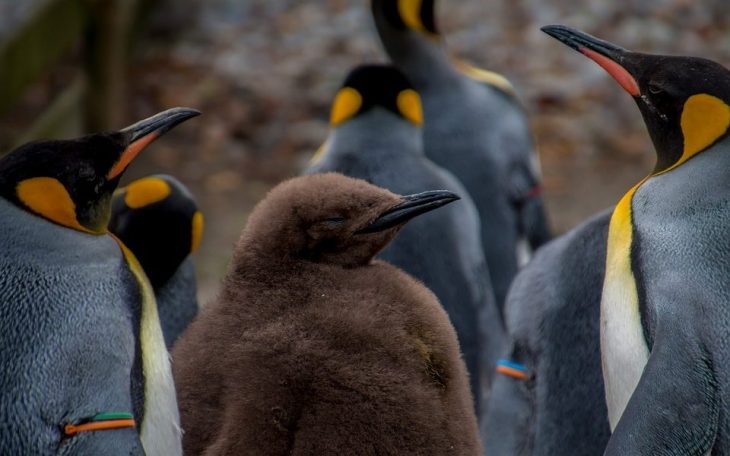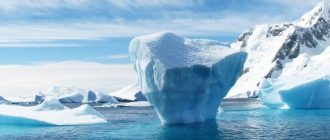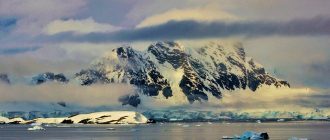For most Antarctic animals the main determining factor in their distribution is their access to the sea or, for parasites, their access to the animals of the sea. The animals of the inland include threadworms, tartigrades and rotifers at the smallest end of the scale, and at the largest, springtails, mites and even three species of fly-Belgica antarctica, Parochlus steinenii and Telmatogeton magellanicus.
More closely allied to the harvest from the sea are the parasites found on birds and seals-lice, mites and ticks and the Antarctic flea, Glaciopsyllus natarairus. On the islands, the larger of the invertebrates include earthworms, snails, spiders, springtails, beetles and crustaceans, as well as a species of wasp, Aniarctopria fatigaster, on Macquarie Island. Smaller invertebrates include mites, thrips, aphids, tartigrades, threadworms and booklice which, as well as hooks, also feed on fungi and plant tissue.
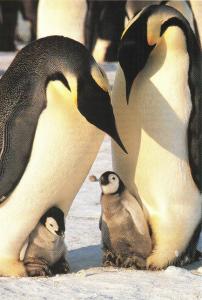
Life on the fast ice
The coastline and the stable ice offshore (known as fast ice) teems with life wherever there is bare ground exposed for nesting for the two main species that breed there-the emperor penguin, Aptenodytes forsteri, and the Weddell seal, Leptonycbotes weddeli.
The female 30 kg (66 pound) emperor penguin lays her single egg on the ice in April or May and the male then incubates it on his feet for 60 days. At about the time of hatching the females return with food.
The chicks are then brooded on the feet for a further 40 days. Weddell seals’ pupping season begins in spring when the young are born at a weight of 25 kg (55 pounds) and grow rapidly to over 100 kg (220 pounds) at weaning. During this time the males stake out underwater territories and feed on crustaceans and fish from the shallow water.
By the end of December thc males are out on the ice, resting and recovering from wounds; the mothers try to coax their pups into the water. Once the ice scans to break up the seals move out to sea and their diet changes to more pelagic fish.

For another species of penguin, the Adelie (Pygoscelis adeliae) the extent of the ice is critical to the survival of their young. Too much ice means that the adults have to use up more energy, and consequently make fewer trips to the sea to bring krill and fish back for their growing chicks.
One animal associated with the Adelie is the leopard seal, Hydrurga leptonyx, which feeds inshore on Adelies during their breeding season and is the key reason for the penguins’ hesitancy when entering water.
Other birds which need access to the sea but are less constrained by the extent of fast ice are the petrels. Antarctic petrels (Thalassoica antarctica), Cape petrels (Daption capense) and southern fulmars (Fulmarus glcialoides) all nest on exposed rock ledges from December, while snow petrels (Pagodroma nivea) and the tiny Wilson’s storm petrel (Oceanites oceanicus) nest under the cover of rocks to hide from predatory skuas.
Southern giant petrels (Macronectes giganteus) breed near the stations at Casey and Davis, which is the furthest south they will breed but, possibly for the same unresolved reason as the decline of elephant seals, numbers have been falling for years.
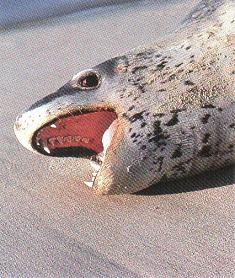
Pack-ice inhabitants
The pack-ice-the great barrier of detached floating ice surrounding the continent-provides nor only resting sites for penguins but breeding grounds for three species of seal-the Ross (Ommatophoca rossii), crabeater (Lobodon carcinophagus) and leopard (Hydrurga leptonyx).
The crabeater is the most common seal in the world and feeds mainly on krill. Far less is known about Ross and leopard seals, mainly because they breed deep in the pack-ice.
Although the leopard seal feeds on penguins, fish and krill, it also attacks seal pups. The rare Ross seal has backwardly curved canines and incisors which help it to grip its rather slippery food of squid.
The sharp teeth and wide jaws of the leopard seal (Hydrurga lepconyx) enables it to tear chunks out of its prey. It feeds mainly on penguins but also eats fish, squid and krill.
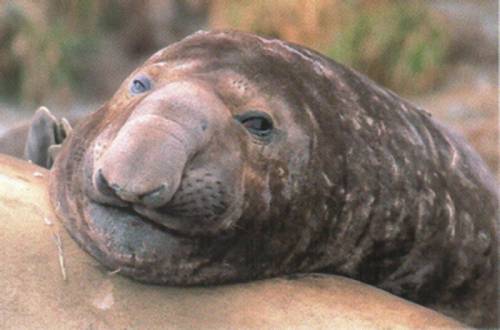
The islands
Heard Island differs from Macquarie Island in that it does not have any introduccd animals (or plants, for rhar matter). On Macquarie Island feral cats and rats play havoc with nesting petrels, and rabbits destroy the vegetation-these pests are subject to ongoing control programs by the Tasmanian Parks and Wild-life Service. (The environment on Heard Island may have been too severe to support these species.)
Apart from that, both islands share a rather similar fauna that includes elephant seals. fur seals, four species of penguin, albatrosses, petrels and cormorants and an abundant invertebrate population.
Wind plays quite a significant part in the islands’ ecology. Macquarie Island, for example, receives visits from landbirds blown off course from Australia (once including a racing pigeon released in Mount Gambier en route to Tasmania).
While Strong winds bring some ocean wanderers such as the light mantled sooty albatross (Phoebetria palpebratn) and wandering albatross (Diomedea exulans) to both islands, and in addition the grey-headed (D. chrysostoma) and black-browed albatrosses (D. melanopbris) to Macquarie, they can also be restrictive to birds with a smaller wingspan.
Both islands have endemic cormorants chat only forage 20 km (12 miles) or so away from land and on Heard Island one bird, the lesser sheathbill (Chionis minor), doesn’t go to sea at all. It is still a puzzle as to how this landbird arrived there. Wind also affects the insect population, resulting in the evolution of wingless moths, flies chat walk and, on Macquarie Island, a wasp without wings, Antarctopria latigaster.
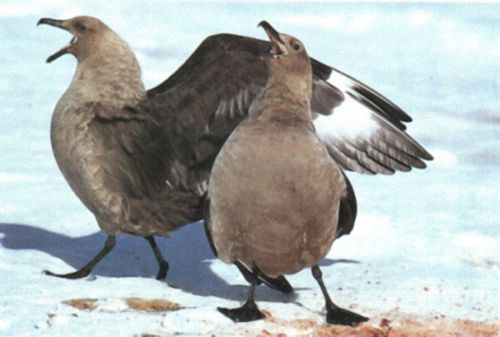
Elephant seal populations are both Macquarie and Islands Heard have declined from the first census figures taken in the 1940s and ’50s to less than half that number, with tire cause still under investigation. Weighing up to 4000 kg (8820 pounds) and ofren reaching a length of over 6m (20 feet), the southern elephant seal (Mirounga leonina) is the largest of the world’s seals and dives the deepest, to about 2000 m (6560 feet), where it can remain submerged for up to two hours.
Elephant seals feed on squid and fish as far away as the mainland waters of Australia and Antarctica. The males come ashore in September/October to establish territories where they collect a harem of up to 20-30 females. The defence of their breeding rights can lead to very bloody fights, with the result that many adult bulls are covered with battle scars. More often, however, a veteran bull will use intimidation a roared challenge, upright posture with open mouth and inflated proboscis and, occasionally, a sudden charge-to deter a less experienced rival.
Fur seals may also defend a harem but numbers in these groups are much smaller, consisting of about five females. On Heard Island the population consists of Antarctica fur seals (Arctocephalus gazella); while at Macquarie Island there is an interbreeding Antarctic/Subantarctic fur seal population (A. tropicalis) as well as a population of non-breeding New Zealand fur seals (A. forsteri). Unlike southern elephant seals, fur seal numbers are booming worldwide, possibly due to the fall-off in competition for krill from reduced numbers of whales.
Both Macquarie and Heard islands support four species of breeding penguin-king, rockhopper, gentoo and macaroni (Heard) or royal, Eudyptes schlegeli (Macquarie). The macaroni penguin (E. chrysolophus) is unusual in that the first egg is always discarded as soon as the second is laid so that die penguin only raises one chick, a phenomenon still not understood.
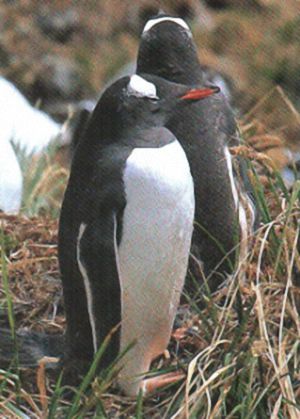
Both the gentoo (Pygoscelis papua) and rockhopper (Eudyptes chrysocome) penguins forage in shallower waters, while the macaroni and royal penguins tend to go further a field and may dive regularly to around 60 m (200 feet). King penguins (Aptenodytes patagonica) also range over to sea but they can dive to as deep as 240 m (790 feet).
Of the other birds, the land-based sheath bill (Chionis minor) makes its living by scavenging and even vampirisrn.
This habit may have been started by opportunism (picking at the wounds of elephant seals) but it now extends to the deliberate picking of the hind flipper of these and leopard seals in order to drink their blood.
The main scavengers of seals are the Subantarcric skuas, Catharacta lonnbergi (larger than their Antarctic cousins), and both the northern and southern giant petrels (Macronectes halli and M. giganteus).
Cape petrels also breed at Heard Island and they scavenge in the sea around carcasses of seals and penguins killed by leopard seals. As well, gulls and terns make a living from the shallow nearshore area.
The most numerous birds found at Heard Island are the smaller petrels-South Georgia diving petrel iPelecanoides georgicus) and common diving petrel (P. urinatrix), dove (or Antarctic) prion (Pachyptila desolata) and fulmar prion (P crassirostris) and the ubiquitous Wilson’s storm petrel.
All of these birds feed on plankton and generally come ashore to their nests each night. The birds that breed on Macquarie Island include the blue petrel (Halobaena caerulea), the white-chinned petrel (Procellaria aequinoctalis), the Antarctic and fairy prions (Pachyptila turtur), the sooty shearwater (Puffinus griseus), the grey-backed storm petrel (Garrodia nereis) and also the common living petrel (Pelecanoides urinatrixt).

